
How paid campaigns affect your app’s organic traffic
Journal 5 David Vargas January 17
Explore the connection between paid campaigns and organic app growth—and how to make them work together.

Nearly all apps today use paid campaigns to grow. After working with more than 95 apps over the last six years, I’ve seen how important paid traffic is—not just for driving installs but also for improving organic traffic. In the long run, organic traffic is what creates the consistent cash flow apps need to scale effectively.
Paid campaigns significantly influence organic traffic, no matter the channel. Yet, paid campaigns and ASO (App Store Optimization) are often handled by separate teams. To thrive it’s essential to understand how these two areas work together.
In this post, we’ll cover:
- Why optimizing ASO is crucial before running paid campaigns.
- How ASO and paid user acquisition (UA) support each other.
- Real-world examples of how paid campaigns can boost organic growth
Why optimizing ASO is important before running any paid campaign
ASO is the process of improving an app’s visibility to increase downloads. Before launching paid campaigns, it’s critical to ensure your ASO is fully optimized.
There are three major things we tend to focus on:
- Keyword optimization: Picking the most important and relevant keywords for the app, considering competition, opportunity, and popularity within the stores.
- Conversion rate optimization (CRO): Improving the percentage of people who download the app after landing on the app page. This is done by optimizing visual elements like the app icon, screenshots, preview video, and preview banner.
- App presence optimization: Getting more impressions on the stores by creating app events, special offers, or getting featured.
The main advantage of ASO is that it doesn’t require a direct budget to start. But its success depends on factors like impressions, CTR, competition, and daily install volume. Every user—whether from a paid ad or an organic search—must visit your app page before downloading. A well-optimized page improves conversion rates, which boosts keyword rankings and enhances the performance of paid campaigns. In short, better ASO reduces your CPI (cost per install), making campaigns more effective.
How to know if your app page is ready for paid campaigns
To determine if your app page is ready, start by reviewing your conversion rates. Platforms like Google Play Console and App Store Connect provide benchmarks that help you compare your app’s performance with similar ones.
Here’s how each platform calculates conversion rates:
- Google Play Console: Installs ÷ visits
- App Store Connect: Installs ÷ impressions
Because visits reflect users who actively click into your app page, many consider this the more accurate metric. By contrast, impressions include users who only see your app in search results or ads, excluding the influence of key elements like screenshots or videos.
To check benchmarks:
- Google Play Console: Go to “Grow Users > Store Performance > Listing Conversion Analysis.” Filter by country or other variables as needed.
- App Store Connect: Navigate to “Analytics > Benchmarks” to compare metrics like conversion rates and performance percentiles for your category.
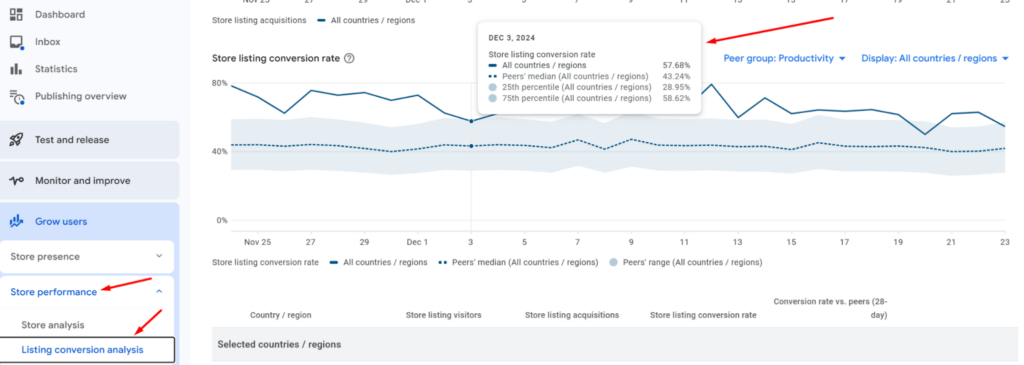
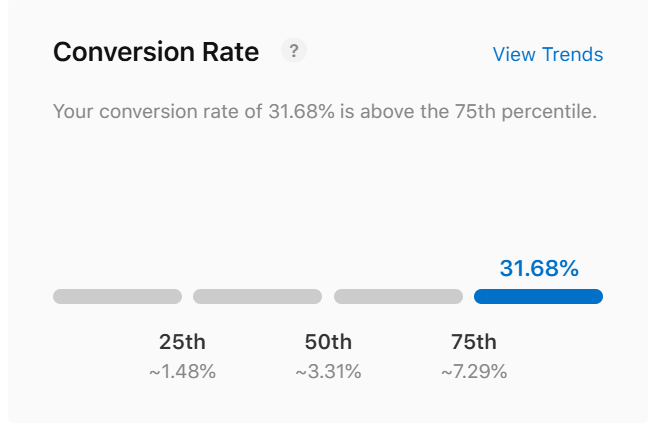

As you can see, both consoles give you a direct comparison of how your app page is doing compared to your peers’ median, and the 25th and 75th percentile. The process is quite straight and it will give you an idea about if your app page is really attractive and appealing for the users that you are targeting.
If your app is totally new and you don’t have historical data, you will still see the median and percentiles from your category so as soon as you start to get some traffic (either with a paid campaign or organically), you will see if you can continue with the campaigns or if you have to stop, optimize your ASO and then reactivating your campaigns with an appealing and attractive app page.
If your app is new and lacks data, use category benchmarks to set expectations. As traffic grows, review your conversion rates and pause campaigns if adjustments are needed. Focus on improving your app page, then resume paid campaigns when your ASO is stronger.
The synergy between ASO and paid UA: Why daily install volume matters
Now that we’ve covered why conversion rates are critical before running paid campaigns, let’s talk about the synergy between ASO and paid UA. Beyond improving conversion rates, paid campaigns also impact your keyword rankings and discoverability.
The connection between ASO and paid UA is stronger than ever due to increasing competition in every category. Large companies and viral apps dominate the top positions for relevant keywords. However, medium and small apps still have a chance to improve their rankings by using paid campaigns strategically.
Once you’ve ensured a good conversion rate, starting paid campaigns is the fastest way to boost your organic rankings and increase your chances of getting featured.
For example, a new subscription app launched in October 2024 used Meta campaigns targeting Australia and Canada. Within days, it grew from zero to over 150 installs per day in each country. This increase in installs directly improved keyword rankings, going from zero-ranked keywords to more than 500.
Interestingly, the number of ranked keywords peaked on days when the ad spend was highest. This proves the strong connection between paid campaigns and ASO performance.
Real examples of paid campaigns driving organic growth
Case 1: A new app
This first example is a new subscription app that started a paid campaign in Meta at the beginning of November targeting Australia and Canada:
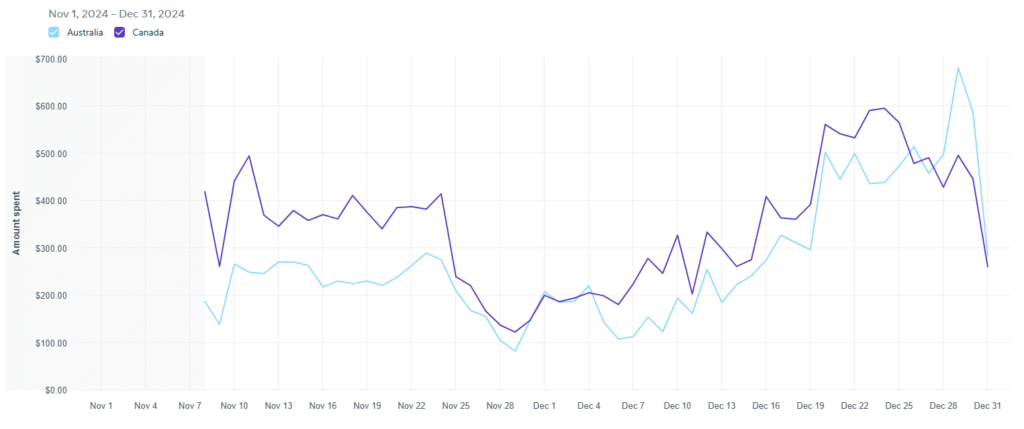
This app had zero presence in these countries—this is also clearly visible if we take a look at the downloads in App Store Connect:
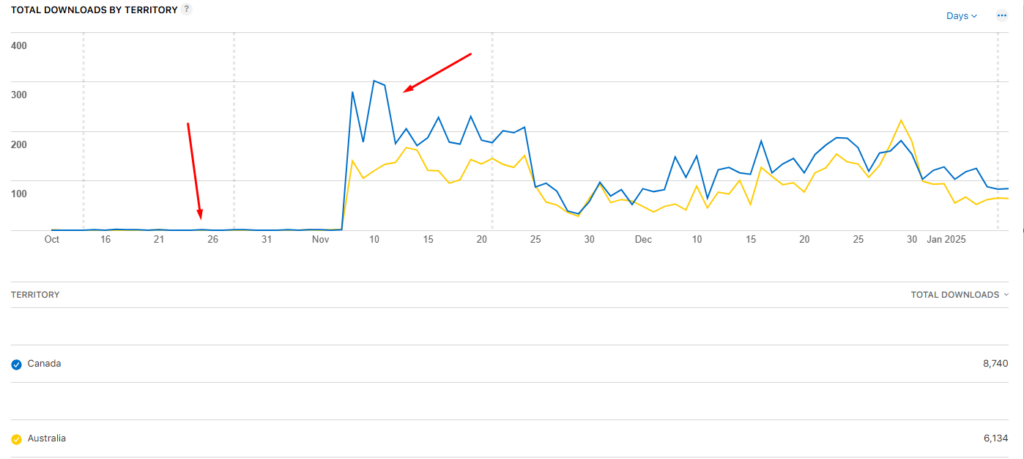
The effect of the paid campaign is pretty clear, right? We passed from zero to +150 installs per day in each country. We kept running the campaign until the end of December and this is what happened with our keyword rankings in both countries:
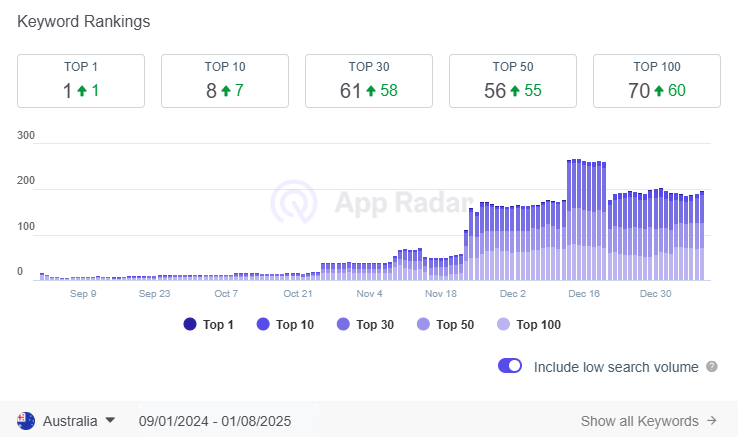
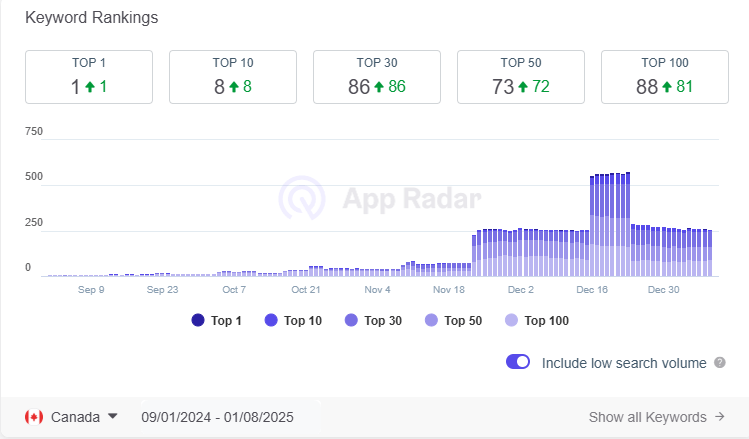
What a jump, right? In both countries, we passed from zero ranked keywords to more than 500 on the best days. One clear bit of evidence showing how paid campaigns are connected with your ASO: The days where we got more keywords positioned were the days where our spend was the highest! From Dec 14th, both countries got a massive jump in the number of keywords positioned.
If you still believe this is a coincidence, I have more evidence on why only paid campaigns could do this—how the app was ranking in its main categories before and after starting the paid campaigns.


And again, we have the same coincidence in the category rankings. The app did not have any positions until paid campaigns were started in both countries. Also, we got the highest position on the days when the spending was the highest!
Why this happened is pretty clear. The only factor that changed was the number of daily installs that both countries generated so it is pretty clear that increasing your daily install volume is key to growing organically. This is also something that we can easily see in App Store Connect by filtering how search traffic has evolved in both countries
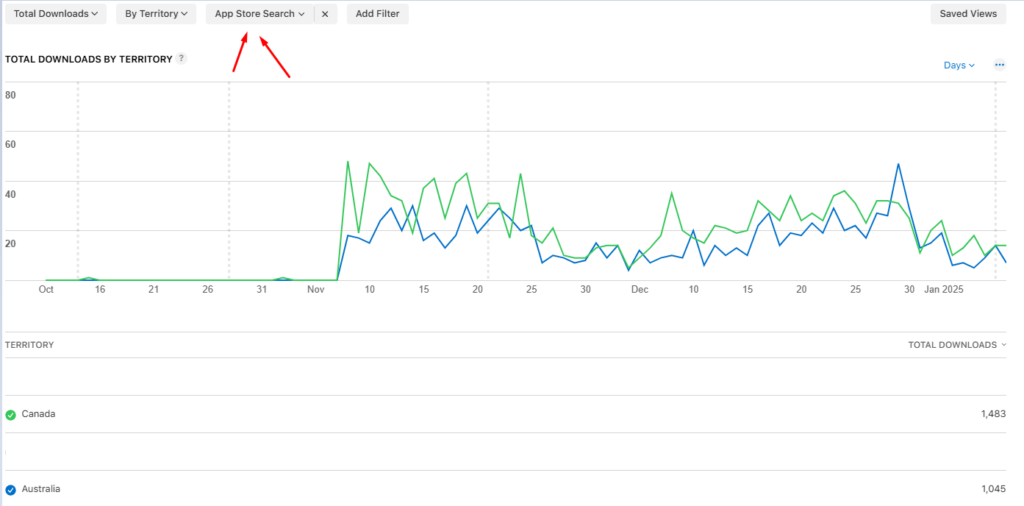
Again, the search traffic (aka users who viewed your app or downloaded it from search on the App Store) is growing exactly at the same rhythm as paid campaigns.
At this point you may think that you found a gold mine but, unfortunately, it is not that simple, because many of those “search” downloads are actually users that you paid for. For example, if one user watches your ad and then two days later downloads the app, this user is not counted as a paid user due to the limits in the attribution windows.
Moreover, this organic traffic can’t keep that level of “organic” installs by itself and that is something that you will quickly see when you stop the campaigns. In this specific example, we also ran a paid campaign in the United Arab Emirates and we had the same behavior in keyword and category rankings as Australia and Canada. However, once we stopped the campaigns, the organic uplift went quickly to the ground:
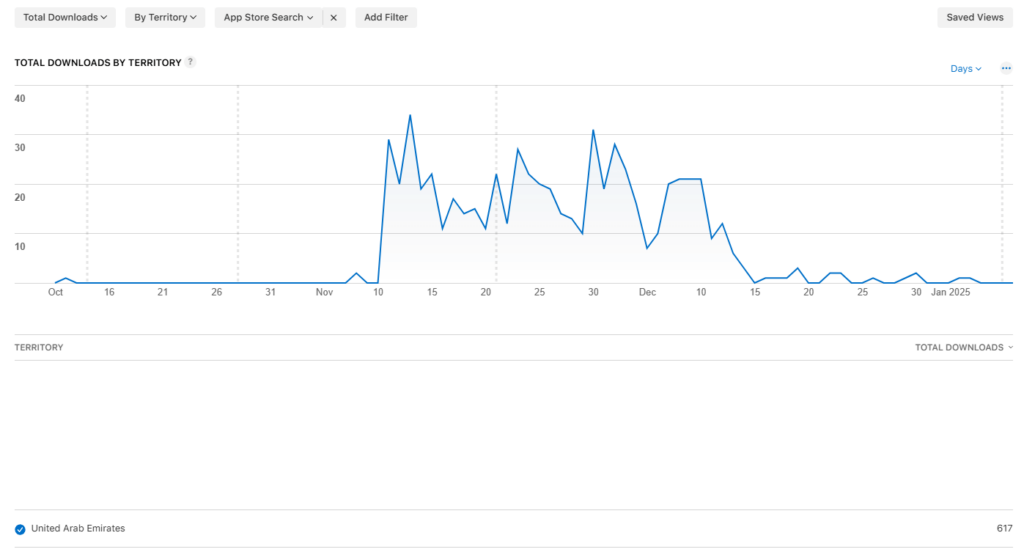
Case 2: A mature app
This second example illustrates how increasing daily install volume can really help you even when you have a mature app which has been active in the market for +10 years.
In this case, the company had a really big budget for Google Ads (+$400k/month) and we were already spending a very decent amount in Germany, one of our target countries, so the daily install volume was already high.
However, we decided to test what level or organic uplift we could get if we increased the daily install volume.
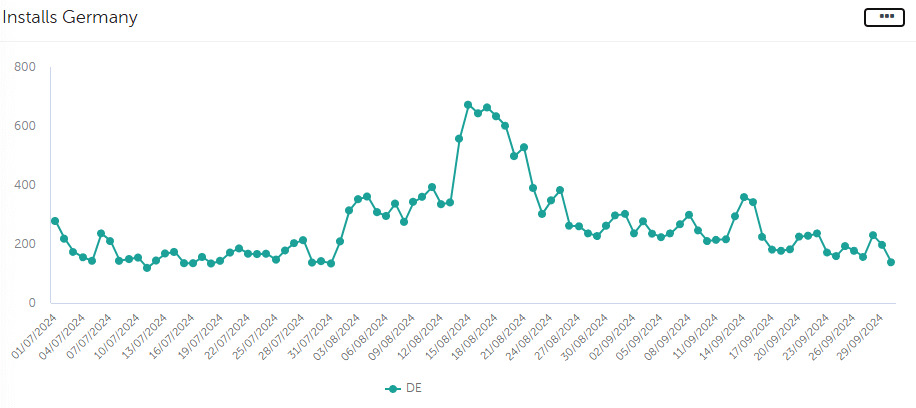
As you can see, we elevated the daily install volume from ~200 installs/day to more than 500/day with paid campaigns. And the question is: what does doubling daily install volume bring to the table when you have been active in the market for many years?
It brings more keywords during the days that campaigns were active:
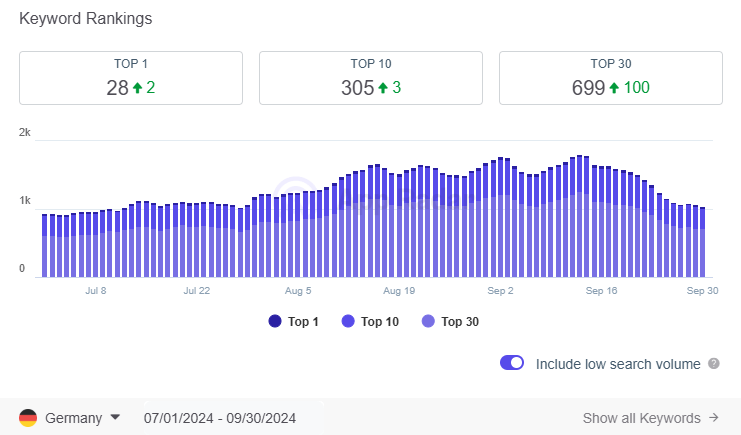
And it brings a jump in category rankings from position 60-80 in average to 5th position in less than four days! And again the highest positions in the category rankings exactly match the days where our daily install volume was the highest.

This looks so huge, right? It is like those who have the deeper pockets will be the ones that will control the market and this is true to a point, but there are some pitfalls that we need to consider.
In this case, as soon as we stopped the extra campaigns that were doubling the daily install volume, the organic rankings also went down so keeping this level of spend only because of a higher organic traffic only makes sense if and when the organic uplift brings you the money to cover the investment.
How to decide if increasing daily install volume is worth it
At this point, you’re probably asking the most important question: is increasing daily install volume worth it? And you’re right to focus on this—it’s the key to deciding your paid UA strategy.
There are many ways to measure this, and every company will approach it differently depending on their internal constraints and goals. However, from my experience, one approach always works: focus on whether the organic uplift increases your revenue baseline. This is the ultimate evidence you need when testing an increase in daily install volume.
The process is straightforward:
- If the increase in daily install volume brings more organic installs—and those organic installs lead to higher organic revenue—then it’s worth investing. The combined organic and paid revenue should meet or exceed your profitability targets.
- If the higher install volume generates more organic installs but no significant jump in organic revenue, the effort isn’t worth continuing.
- If the increased daily install volume doesn’t lead to any noticeable organic uplift, it’s a clear sign to stop and reevaluate your approach.

This framework assumes that higher ad spend will naturally lead to higher paid revenue. But if your campaigns aren’t generating more paid revenue to begin with, this whole test falls apart. The organic uplift alone will rarely compensate for underperforming paid campaigns.
Each app is different, so the impact of organic uplift varies depending on factors like competition, seasonality, and product metrics. There’s no exact formula to predict how many daily installs you need to affect rankings, but the good news is that results appear quickly. You can usually measure the organic uplift in installs and revenue within a week.
Here’s my advice: test for a short period. Analyze the results while keeping your profitability margins in mind. This approach will show you whether higher spend can drive growth and profitability over time.
In summary
ASO and UA are deeply connected. Paid campaigns amplify your ASO efforts by driving daily installs, which improves rankings, visibility, and discoverability. However, sustained success depends on testing, balancing budgets, and optimizing your app page for conversion.
Start with a strong ASO foundation, then use paid campaigns strategically. Evaluate results, adjust as needed, and build a growth plan that balances short-term wins with long-term profitability.







